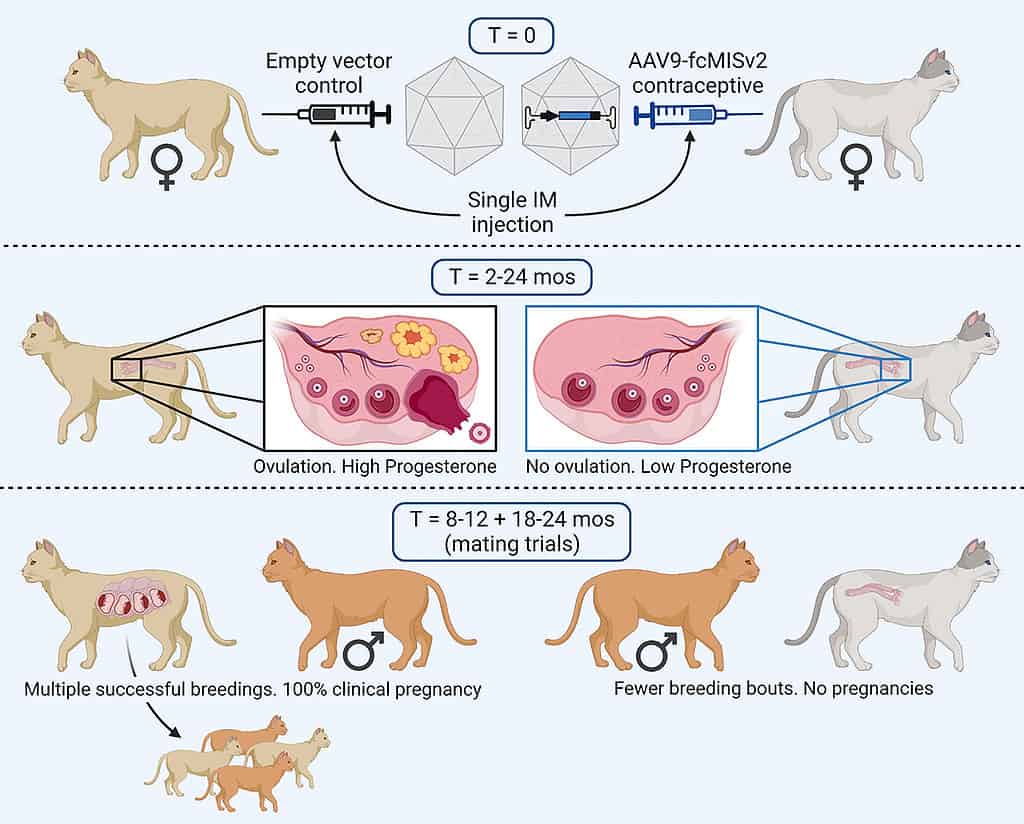In the quiet corners of our cities and plains, a silent crisis is unfolding. Stray cats, often unnoticed by the hustle and bustle of human life, are multiplying in alarming numbers. There are hundreds of millions of stray cats on the planet, many of them living in dreadful conditions. Plagued by disease, struggling for food, and struggling with hardship, many stray feline populations are also faced with overpopulation.
Enter the world of feline contraceptives. Sterilizing stray cats is a promising solution that can revolutionize how we manage our feline friends. But catching them, performing the procedure, and releasing them back safely is very time and labor-intensive.
This is where a new solution comes in. Researchers have developed a single, injection-type contraceptive that could help manage stray cats populations humanely.

Researchers in the US have developed a non-invasive, single-dose gene therapy contraceptive injection that can potentially control stray cat populations across the globe.
Cats are so cute, why do we even need such an intervention?
Well, you may not believe it but there are 480 million stray cats in the world. In fact, 80% of all domestic cats are stray. They roam freely, live in unhygienic conditions, experience poor welfare, and often get hit by vehicles.
Stray cats are also disruptive to kill small animals in large numbers across their roaming range. For instance, a report from the Invasive Species Council reveals that the native cat population in Australia caused the extinction of 27 animal species. Moreover, many stray cats might also carry diseases and infections. Therefore, it is important to keep their numbers in check.
David Pepin, one of the researchers and an associate professor of surgery at Harvard Medical School, told ZME Science:
“These cat populations are either targeted for euthanasia or trap-neuter-return programs (i.e., surgical sterilization), but these approaches have limited effectiveness. Many free-roaming cats experience abbreviated, traumatic lives which have negative effects on wild birds and other wildlife species.”
Simply put, conventional control methods for stray cat populations simply don’t cut it anymore. This is why the researchers sought out a new effective and easy-to-implement solution that could address the significant ethical, economic, and environmental concerns associated with free-roaming cats.
How does a single-dose cat contraceptive work?

In the US alone, there are nearly 80 million free-roaming cats who have no owner. Countries in the European Union have over 100 million stray animals, many of which are cats. Currently, no permanent non-surgical contraceptives exist for use in stray cats.
Researchers used a viral gene therapy vector (adeno-associated virus or AAV vector) to deliver a naturally occurring ovarian hormone called anti-Müllerian Hormone or AMH. This hormone regulates the growth and maturation of follicles in feline ovaries, which is necessary for ovulation.
The vector is injected into a muscle, which then takes up the gene and starts secreting AMH. The elevated AMH levels in the blood then inhibits ovulation (the release of egg or ovum from the ovary).
If there is no egg, there will be no fertilization, and eventually, the cat will not become pregnant.
Testing the contraceptive injection
The study involved nine adult female cats, which were observed for two years following their treatment. Six of the cats received the actual gene therapy, while the other three served as controls. The single-dose treatment successfully prevented pregnancy in the six cats. Plus, none of the cats experienced any side effects.
“We have shown efficacy for two years but have not yet demonstrated lifetime contraception with a single injection, which is our goal with this treatment,” said Pepin.
When asked when the contraceptive would be available for use, he further added: “Ongoing studies are looking at the safety and efficacy of this approach in female kittens. Our preliminary data suggest it is just as effective in female kittens. We are currently in talks with the FDA to pursue clinical trials but It is difficult to estimate the timeline. It will likely be years before this treatment is available in veterinary clinics.”
The researchers are also working to modify the vector and transgene to make the treatment more efficient and reduce cost. Hopefully, a single-dose solution that is secure, economical, and efficient will soon be available to limit the stray cat population on the planet.
The study is published in the journal Nature Communications.






